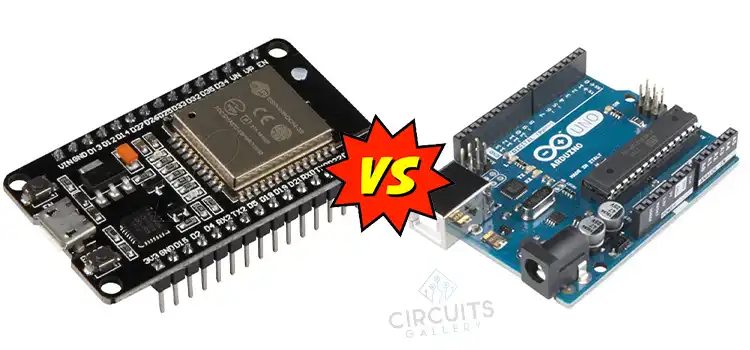ESP-IDF vs Arduino | Differences Between Two Development Framework
Two of the foremost noticeable platforms in embedded systems are ESP-IDF and Arduino. Whereas both are designed to simplify the method of developing firmware for microcontrollers, they cater to distinctive audiences and have particular preferences.
ESP-IDF, the official development framework for the ESP32 chip series, offers a comprehensive set of features and flexibility, making it a favorite among advanced developers. On the other hand, Arduino, with its user-friendly interface and tremendous community support, has ended up being the usual choice for beginners and specialists.
This article dives deep into the nuances of both platforms, comparing their limitations, strengths, and ideal use cases, giving readers with a clear perspective on which to select for their projects.

Brief Overview of ESP-IDF and Arduino Development Frameworks
Here is a brief discussion on ESP-IDF and Arduino:
ESP-IDF
ESP-IDF is Espressif’s official toolkit for the ESP32 microcontrollers. This comprehensive framework offers plenty of libraries and tools tailored for IoT applications. Outstandingly, it supports both standard C and C++, enabling effective, high-performance coding.
Key features incorporate Bluetooth and Wi-Fi connectivity, a tremendous array of drivers for sensors and peripherals, and over-the-air (OTA) upgrade capabilities.
It moreover boasts a secure boot and is built on the FreeRTOS real-time operating system. A standout feature is the ESP Rainmaker, a platform designed for crafting cloud-connected devices.
Arduino
Arduino is a globally recognized open-source electronics platform, designed to make programming and hardware development accessible. Celebrated for its beginner-friendly interface, Arduino has democratized the world of microcontroller projects.
Its integrated development environment (IDE) and programming language allow for a seamless transition from idea to execution. Arduino’s tremendous library ecosystem supports a range of hardware interactions, from fundamental input/output tasks to complex Wi-Fi and Bluetooth communications.
While its C/C++ language adaptation is tailored for microcontroller needs, it sometimes limits advanced functionalities. Still, Arduino remains a cornerstone within the creator community, bridging the gap between novices and intricate electronics.
Comparative Analysis of ESP-IDF and Arduino Development Frameworks
Here is a detailed comparative analysis of ESP-IDF and Arduino:
1. Origin & Core Purpose:
ESP-IDF: Created by Espressif Systems, ESP-IDF is the official development framework for the ESP32 and ESP32-S series of microcontrollers. It’s meticulously created to serve as a comprehensive stage, especially for IoT applications, leveraging the complete capabilities of the ESP32 chipset.
Arduino: Born from a project at the Interaction Design Institute Ivrea in Italy, Arduino has evolved into a universally recognized open-source electronics platform. Its primary aim is to democratize hardware and software development, bridging the gap between complex electronics and enthusiasts.
2. Development Environment & Toolchain:
ESP-IDF: Utilizes a more complex toolchain, demanding familiarity with command-line operations. It offers a more profound control over the development environment, integrating seamlessly with platforms like CMake.
Arduino: Features a GUI-based IDE, rearranging the development lifecycle from coding to deployment. Its plug-and-play nature with different boards is a testament to its user-centric design.
3. Language & Compilation:
ESP-IDF: Embraces both standard C and C++, facilitating the creation of efficient, high-performance firmware. Its compiler optimizations and profiling tools empower fine-tuned performance.
Arduino: Works on a customized form of C/C++, optimized for microcontroller environments. While this guarantees ease of use, it might sometimes restrict certain advanced language features.
4. Libraries & Integration:
ESP-IDF: Comes packed with libraries that cater to advanced networking, including Wi-Fi 802.11 b/g/n, BLE, and classic Bluetooth. Its modular architecture means developers can integrate only the required components, guaranteeing lean firmware.
Arduino: Its strength lies in its tremendous, community-driven library ecosystem. From basic LED controls to complex IoT protocols, there’s likely a library or shield module accessible.
5. Real-time Capabilities:
ESP-IDF: Built on the FreeRTOS kernel, it offers genuine real-time multitasking capabilities, fundamental for complex IoT applications.
Arduino: While it can handle concurrent operations utilizing interrupts and timers, it doesn’t natively support a real-time operating system.
6. Community, Documentation & Back:
ESP-IDF: While its community is burgeoning, particularly among seasoned developers, its documentation is thorough, catering to in-depth technical implementations.
Arduino: Arduino’s colossal community is its crown jewel. The platform’s tutorials, extensive forums, and shared projects make troubleshooting and learning a communal experience.
Frequently Asked Questions and Answers – FAQs
Can I use the Arduino IDE with ESP32?
Yes, with the ESP Arduino Core, you can program ESP32 and ESP8266 microcontrollers using the familiar Arduino IDE and language.
Do I need to know C/C++ to use ESP-IDF or Arduino?
Both platforms primarily use C/C++. While a basic understanding is beneficial, Arduino’s vast community resources can help beginners get started without deep C/C++ knowledge.
Can I use Arduino libraries with ESP-IDF?
While some Arduino libraries might be ported or have equivalents in ESP-IDF, they are fundamentally different platforms. Direct integration might require adjustments.
Conclusion
In the landscape of microcontroller development, both ESP-IDF and Arduino stand out with distinct strengths. While ESP-IDF offers granular control and advanced features for seasoned developers, Arduino shines with its accessibility and vast community support. Ultimately, the choice hinges on individual project needs and developer expertise.
Subscribe to our newsletter
& plug into
the world of circuits